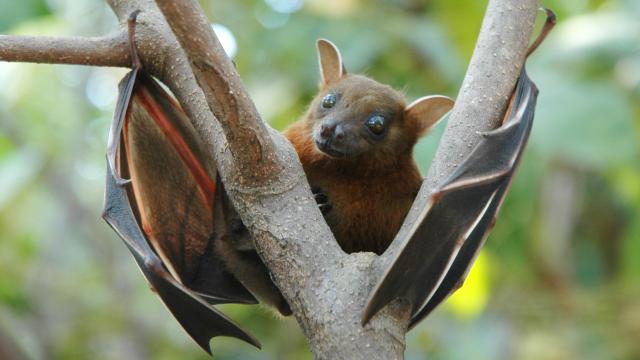The vast majority of infectious human diseases come from animals, yet we know surprisingly little about which animals pose the greatest risk. A new study helps resolve this shortcoming, ranking the mammals that are most likely to spread infectious diseases to humans.
Greater short-nosed fruit bat. (Image: Wikimedia)
Scientists call them zoonotic diseases — pathogens that can spread from one species to another. They also have a term to describe the moment this happens, called a spillover event. Sadly for us, spillovers from animals occur with disturbing frequency, accounting for most of the infectious diseases that afflict our species. We know this is bound to happen again in the future, but it isn’t entirely clear which animals carry the highest risk.
To resolve this shortcoming, researchers from New York’s EcoHealth Alliance conducted an investigation into the mammals that are most likely to trigger spillover events (humans can contract zoonotic diseases from other types animals, such as birds, but we’re particularly vulnerable to mammals owing to our similar biologies). The results of this study, now published in Nature, shows that bats carry the highest risk of zoonotic transmission, followed by primates and rodents.
For the study, a team led by Peter Daszak collected viral data on mammals around the globe. Information from 754 different mammalian species was collected, representing 14 per cent of all known mammals. The database was then fed with information about 585 known viruses that infect mammals, a third of which are known to have made the leap to humans. Other information, such as mammalian family types and geography, was also entered into the system. A mathematical model was then used to estimate the likelihood of viruses jumping to humans.
As the research shows, large animals carry more viruses than small ones, and animals with large geographical ranges carry more viruses than species with highly localised habitats. The research showed that bats were found to carry the largest number of zoonotic viruses, and spillovers were most likely to occur in South and Central America.
This finding meshes well with what scientists already suspected — bats are a primary spreader of disease. So many human diseases are known to have come from bats, including Ebola, Marburg hemorrhagic fever, Nipah virus encephalitis, Hendra virus disease, Histoplasmosis (a disease of the lungs) and severe acute respiratory syndrome. The researchers estimate that there are approximately 17 zoonotic viruses yet to be discovered in every bat species.
Second on the list were primates, particularly those in Central America, Africa and Southwest Asia. Perhaps surprisingly, rodents came in at third, with risk most pronounced in North and South America, and in Central Africa. The researchers say there are about 10 zoonotic viruses yet to be discovered in both primate and rodent species.
It’s important to remember that these are estimates are produced by a computer model, and with incomplete information. Accordingly, the researchers are hoping to add to the database over time, and refine the results. Eventually, the system could be used to predict the next big viral jump, allowing researchers to prepare — or even prevent — an outbreak from happening.
This study doesn’t mean we should hate bats, or try to eradicate them. These flying animals play a huge role in the environment, foraging on insects and even acting as pollinators. Rather, this study suggests we need to keep our distance from bats. Cavers in particular should take note, as spelunking puts them at high risk of coming into contact with these animals.
[Nature]
